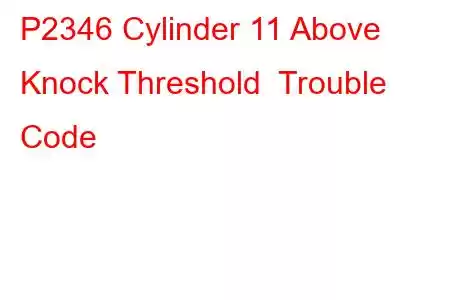P2346 Cylinder 11 Above Knock Threshold
OBD-II Trouble Code Technical Description
Cylinder 11 Above Knock Threshold
What does P2346 mean?
This diagnostic trouble code (DTC) is a generic powertrain code and applies to many OBD-II vehicles (1996-newer). That may include but is not limited to vehicles from Mercedes-Benz, Ford, Sprinter, Nissan, etc. Although generic, the exact repair steps may vary depending on year, make, model and powertrain configuration.
If your vehicle has stored a code P2346 , accompanied by a malfunction indicator lamp (MIL), it means that the powertrain control module (PCM) has detected a signal from the cylinder #11 knock sensor that is not within an acceptable threshold.
The knock sensor is responsible for monitoring excessive vibration and noise in an individual cylinder or bank of cylinders. The knock sensor is part of a low voltage circuit that uses a chemical reaction to noise, and the resultant vibration, to detect an engine knock. Engine knock may be caused by timing, detonation, or internal engine failure. Made with piezoelectric crystals, the modern knock sensor reacts to changes in engine noise with a slight increase in voltage. Since the knock sensor is part of a low voltage circuit, any changes (in voltage) are readily apparent to the PCM.
If the PCM detects an unexpected degree of voltage on the knock sensor (cylinder eleven) circuit, a code P2346 will be stored and a MIL illuminated. Multiple failure cycles may be required for MIL illumination.
What is the severity of this DTC?
When a P2346 is stored, the cause should be diagnosed as soon as possible. Symptoms which contribute to this type of code being stored may range from minimal to catastrophic.
What are some of the symptoms of the code?
Symptoms of a P2346 trouble code may include:
Engine noise Diminished engine performance Reduced fuel efficiency Other related codes There may be no distinguishable symptomsWhat are some of the common causes of the code?
Causes for this code may include:
Bad knock sensor Mistimed engine or improper fuel type Open or shorted wiring or wiring connectors Engine noise caused by component failure PCM or programing errorWhat are some P2346 troubleshooting steps?
Make sure that the engine is filled to the proper level with the appropriate oil and that is in good working order. Actual engine noise, such as spark knock must be eliminated before a diagnosis of a P2346 can be made.
You will need a diagnostic scanner, a digital volt/ohmmeter (DVOM), and a source of reliable vehicle information in order to accurately diagnose a code P2346.
You may save yourself time and trouble by searching for technical service bulletins (TSB) that replicate the code stored, vehicle (year, make, model, and engine), and symptoms exhibited. This information may be found in your vehicle information source. If you find the right TSB, it could yield a speedy solution to your diagnosis.
After you connect the scanner to the vehicle diagnostic port and retrieve all stored codes and pertinent freeze frame data, write the information down (in case the code proves to be an intermittent one). After that, clear the codes and test drive the vehicle until one of two things happens; the code is restored or the PCM enters readiness mode.
The code may be more difficult to diagnose if the PCM enters readiness mode at this point, because the code is intermittent. The condition which caused the P2346 to be stored may need to worsen before an accurate diagnosis can be made. If the code is restored, continue with the diagnosis.
You may obtain connector face views, connector pinout charts, component locator charts, wiring diagrams, and diagnostic flow charts (pertaining to the code and vehicle in question) using your source of vehicle information.
Perform a visual inspe
Read: 24


